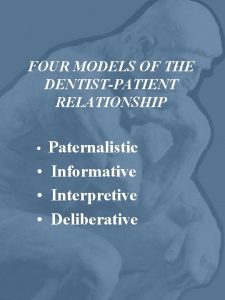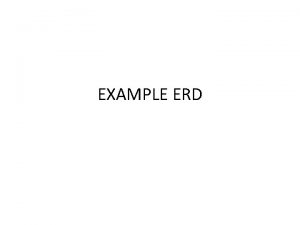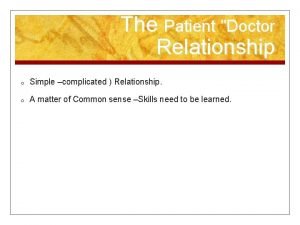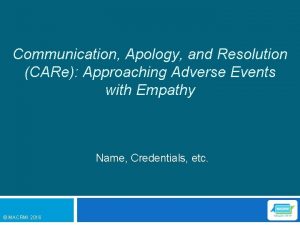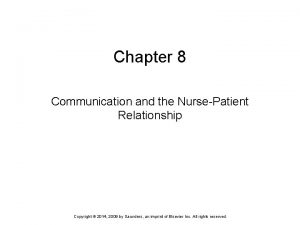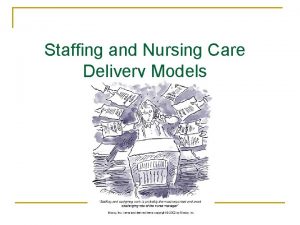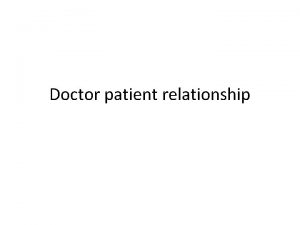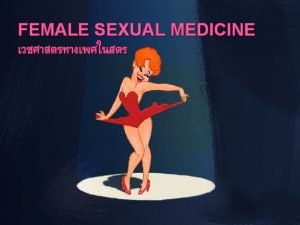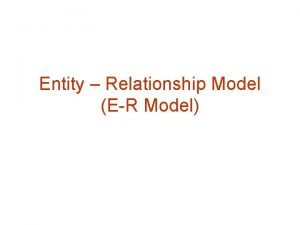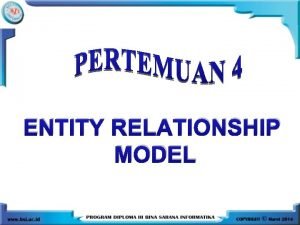Doctor Patient Relationship The Paternalistic autocratic model The
































































- Slides: 64

Doctor Patient Relationship (����� - ���� )

����� - ���� ��� ��� • The Paternalistic (autocratic) model ( )پﺪﺭ ﻣآﺒﺎﻧﻪ • The Informative model ( )آﻤﻮﺯﻧﺪﻩ • The Interpretive model ( )ﺗﻌﺒﻴﺮﻱ



The Paternalistic Approach “If I’ve told you once I told you 1, 000 times, stop smoking!!”







Interviewing effectively (������ )





Transference and Countertransference �������










Specific techniques ( ��� ����� )

���� -( ���� ) ���� (������ ) Open-ended (broad) versus closeended (narrow, directive) questions





















Problematic patients It is a natural human quality to feel anger toward difficult patients, to try to limit the amount of time spent with them, and to hope that they move to another physician! But, doctors primary mission is to provide the best medical care.

Dependent patients Need enormous amount of attention and reassurance. More likely to make repeated urgent calls between appointments demand special consideration. Strategy: ? Firm limits while reassuring the patient that his or her needs are seriously taken and treated professionally

Demanding patients Demand that their discomfort be eliminated immediately become easily frustrated, angry, or hostile if they do not get what they want when they want it! they may be manipulative Strategy: ? Doctor must be firm and clearly define acceptable and unacceptable behavior. Do not forget respect and care, but confront them with their behavior to learn to be responsible.

Narcissistic patients They feel they are superior to every person including they doctor. Tremendously need to be perfect and are jealous to perfect people. They may be rude, arrogant, and demanding. Idealization Vs Devaluation

Suspicious patients They misinterpret neutral events as evidence of acts against them. They are critical and tend to blame other people for every bad thing in their lives. Strategy: ? Be respectful but formal and distant. Expression of warmth often heightens suspicion. Explain in detail every decision and planned procedure.

Isolated patients Do not need or want much contact with other people. They prefer to stand away from the doctor and not to be intimate. Strategy: Respect + distance + don’t get annoyed if they do not mirror your warm behavior.

Obsessive patients Orderly, punctual, and highly concerned with details. Appear unemotional, especially when confronted with bad news. They highly need to be in control of everything and are afraid of losing control. Strategy: Try to include them in their own care and treatment as much as possible. Explain in detail what is going on and what is being planned. Make the patient sure that s/he can make choices in his or her behalf.

Help rejecting patients A big bag of complaints and disappointments They blame others for their problems and make people feel guilty about not caring enough. “Yes, but…” Strategy: ? First of all: Do not get angry!! Take patient’s concerns seriously without encouraging the sick role. Firm limits on doctors availability, but regularly scheduled visits.

Manipulative patients On the surface they are charming, intelligent, polite, and sociable. They often have criminal histories, are used to manipulate and lie! Strategy: Look at their histories Be respectful but alert and suspicious Set firm limits and confront them with their inappropriate behavior.

Compliance (adherence) Definition: the degree to which the patient carries out the clinical recommendations of a treating physician. Examples: - keeping appointments - entering into, and completing the treatment program. - taking medications correctly - following recommended changes in behavior or diet.

Compliance, some statistics l 1/3 of all patients comply with treatment, l 1/3 sometimes comply with certain aspects of treatment, and 1/3 never comply with treatment. l Up to 50% of patients with hypertension do not comply at all with treatment and 50% of those who do, leave treatment within 1 year.

Compliance There is no clear association between compliance and: - sex - marital status - race - religion - socioeconomic status - intelligence - educational level

Factors that increase compliance l Enthusiasm and non-punitive attitude of the physician l Older doctors with experience l Time spent talking to the patients l Short waiting room time l Increased frequency of visits l Doctor-patient match in their priorities

Factors that increase compliance l When doctor explains the names of the drugs, their usage, their effects, and side effects. * l Severity of the subjective feeling of distress or illness. **

Factors that decrease compliance l Complex regimen (multiple agents, multiple small doses)* l Early onset and persistence of side effects l Slow onset of beneficial effects l Psychosis, confusion, dementia, low IQ, impaired hearing or vision, illiteracy l Simple lack of information, need for patient education

Factors that decrease compliance l Asymptomatic diseases such as HTN l Not giving feedback to the patient about the diagnosis or cause of symptoms l Financial barriers l Psychopathologies l Involvement of multiple clinicians l Poor doc-pt relationship
 Non malficence
Non malficence Interpretive model of doctor-patient relationship
Interpretive model of doctor-patient relationship Dr patient relationship ethics
Dr patient relationship ethics Paternalistic leadership
Paternalistic leadership Paternalistic prejudice
Paternalistic prejudice Henry ford paternalistic leadership
Henry ford paternalistic leadership Paternalistic leadership
Paternalistic leadership Doctor doctor google drive
Doctor doctor google drive Diagram of autocratic model
Diagram of autocratic model Erd examples
Erd examples Patient 2 patient
Patient 2 patient Task oriented adalah
Task oriented adalah Alex ferguson autocratic leadership style
Alex ferguson autocratic leadership style Autocratic leadership
Autocratic leadership Coleadership
Coleadership Autocratic buying center
Autocratic buying center Nurse-patient relationship phases
Nurse-patient relationship phases Phases of nurse patient relationship
Phases of nurse patient relationship Phases of nurse patient relationship
Phases of nurse patient relationship Phases of nurse patient relationship
Phases of nurse patient relationship Relationship to patient 書き方
Relationship to patient 書き方 Patient provider relationship
Patient provider relationship Patient provider relationship
Patient provider relationship Therapeutic communication techniques
Therapeutic communication techniques Customer relationship mangement
Customer relationship mangement Team nursing care delivery model
Team nursing care delivery model Kleinman and campbell patient explanatory assessment model
Kleinman and campbell patient explanatory assessment model Team nursing model of care
Team nursing model of care Progressive patient care model
Progressive patient care model Hát kết hợp bộ gõ cơ thể
Hát kết hợp bộ gõ cơ thể Slidetodoc
Slidetodoc Bổ thể
Bổ thể Tỉ lệ cơ thể trẻ em
Tỉ lệ cơ thể trẻ em Gấu đi như thế nào
Gấu đi như thế nào Tư thế worm breton
Tư thế worm breton Hát lên người ơi alleluia
Hát lên người ơi alleluia Kể tên các môn thể thao
Kể tên các môn thể thao Thế nào là hệ số cao nhất
Thế nào là hệ số cao nhất Các châu lục và đại dương trên thế giới
Các châu lục và đại dương trên thế giới Công của trọng lực
Công của trọng lực Trời xanh đây là của chúng ta thể thơ
Trời xanh đây là của chúng ta thể thơ Cách giải mật thư tọa độ
Cách giải mật thư tọa độ Làm thế nào để 102-1=99
Làm thế nào để 102-1=99 độ dài liên kết
độ dài liên kết Các châu lục và đại dương trên thế giới
Các châu lục và đại dương trên thế giới Thể thơ truyền thống
Thể thơ truyền thống Quá trình desamine hóa có thể tạo ra
Quá trình desamine hóa có thể tạo ra Một số thể thơ truyền thống
Một số thể thơ truyền thống Cái miệng bé xinh thế chỉ nói điều hay thôi
Cái miệng bé xinh thế chỉ nói điều hay thôi Vẽ hình chiếu vuông góc của vật thể sau
Vẽ hình chiếu vuông góc của vật thể sau Thế nào là sự mỏi cơ
Thế nào là sự mỏi cơ đặc điểm cơ thể của người tối cổ
đặc điểm cơ thể của người tối cổ Giọng cùng tên là
Giọng cùng tên là Vẽ hình chiếu đứng bằng cạnh của vật thể
Vẽ hình chiếu đứng bằng cạnh của vật thể Phối cảnh
Phối cảnh Thẻ vin
Thẻ vin đại từ thay thế
đại từ thay thế điện thế nghỉ
điện thế nghỉ Tư thế ngồi viết
Tư thế ngồi viết Diễn thế sinh thái là
Diễn thế sinh thái là Dạng đột biến một nhiễm là
Dạng đột biến một nhiễm là Bảng số nguyên tố
Bảng số nguyên tố Tư thế ngồi viết
Tư thế ngồi viết Lời thề hippocrates
Lời thề hippocrates Thiếu nhi thế giới liên hoan
Thiếu nhi thế giới liên hoan

